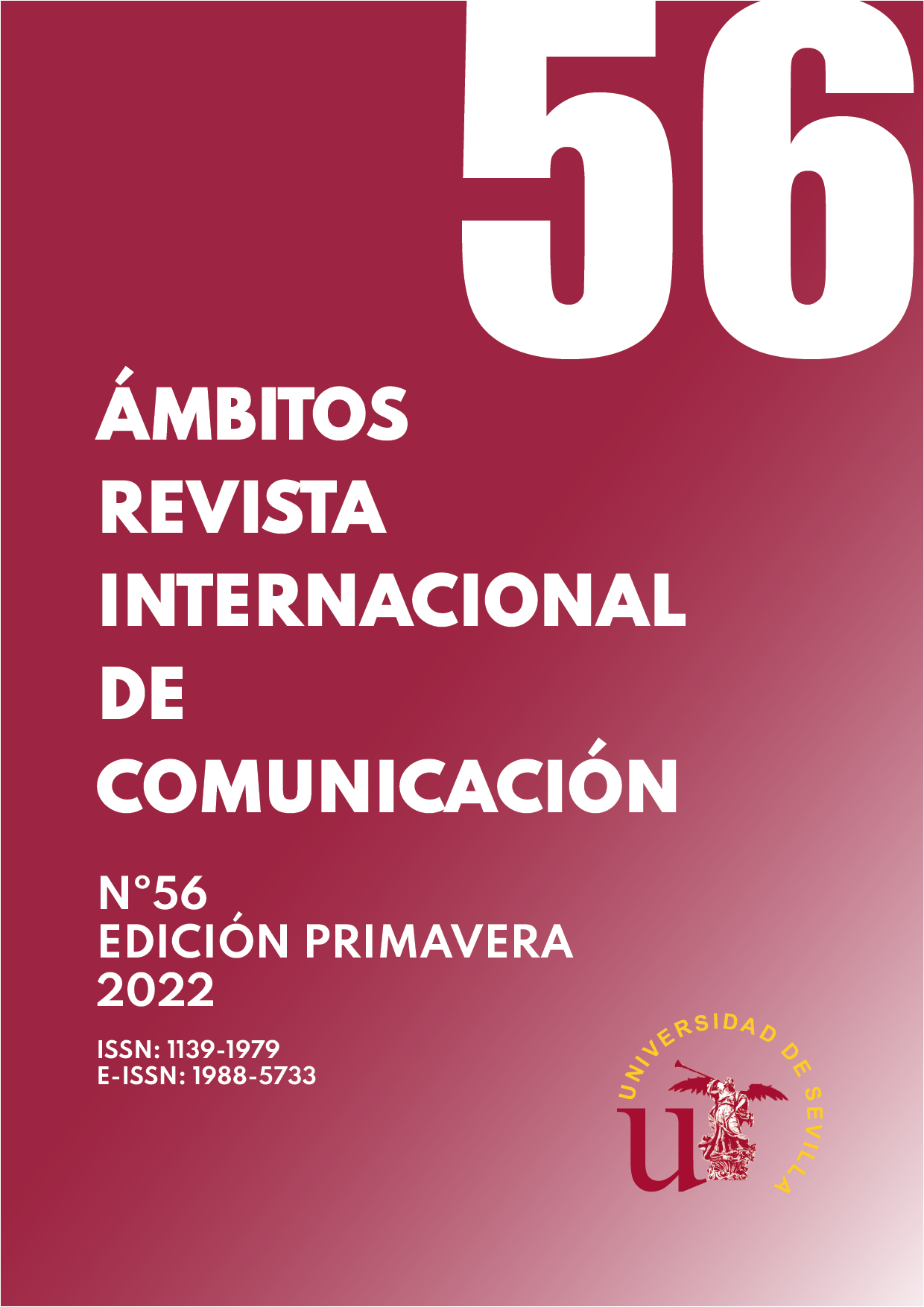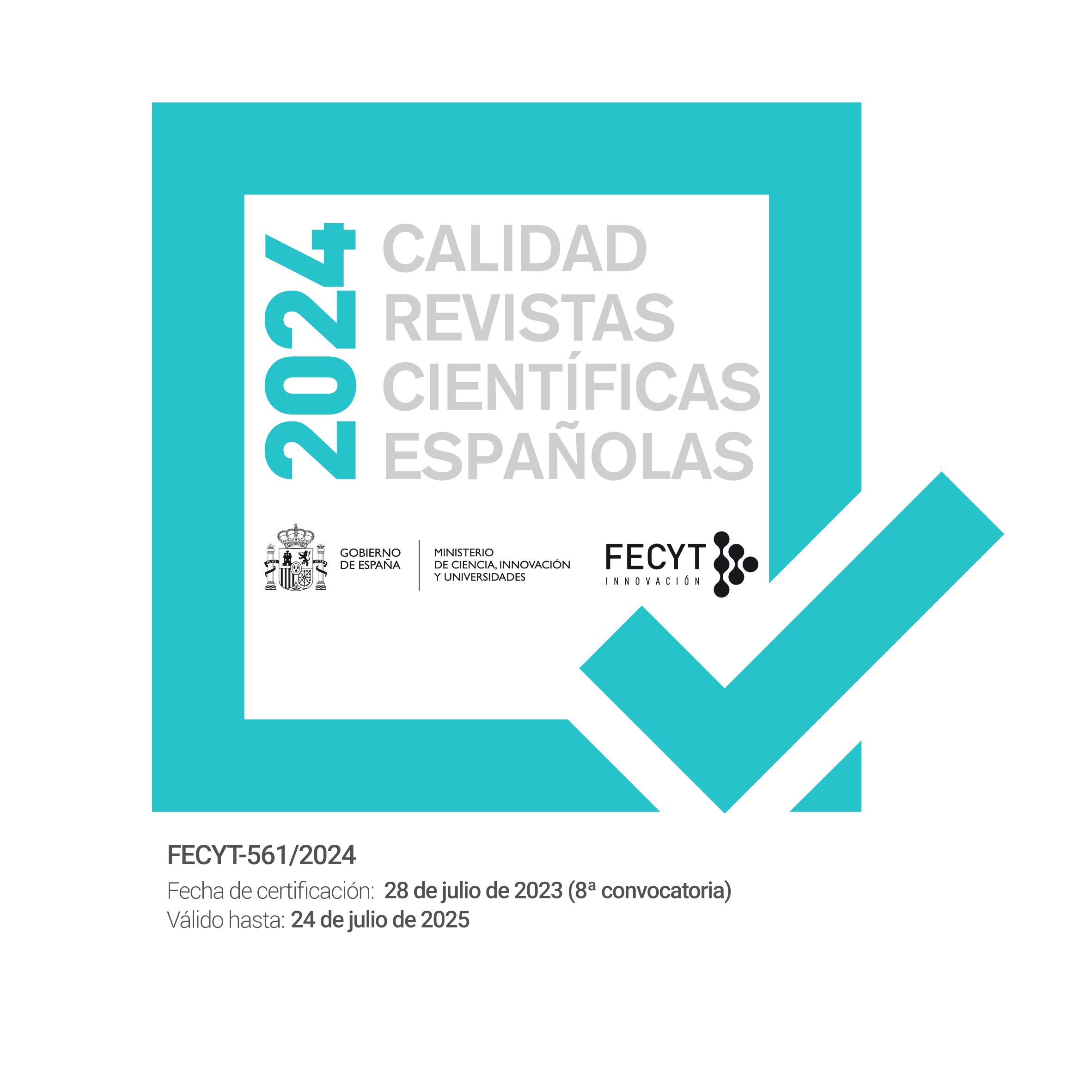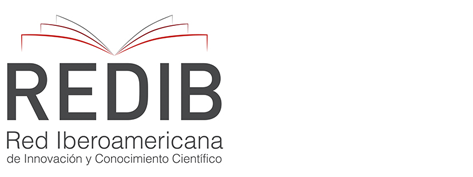Platformization and 360 degree video: implications for journalism in Brazil
implicações para o jornalismo no Brasil
DOI:
https://doi.org/10.12795/Ambitos.2022.i56.06Keywords:
Journalism, Plataform, 360-degree , video, Facebook, YouTubeAbstract
Journalism faces another stage of adaptations and adjustments that emerge through the processes of platformization. New formats emerge with tools offered by technology companies, which in addition to offering distribution conditions, develop orientation and training strategies for journalists. Within this discussion, the focus of this study is 360-degree videos for journalistic purposes disseminated in the Brazilian scenario. Therefore, the objectives are: 1) to discuss the distribution of journalistic videos in 360 degrees in the context of platformization, 2) to understand how Facebook and YouTube influenced the development of this type of content, pointing out advantages and disadvantages of this relationship, and 3) to propose the use of the term pedagogic platforms to discuss the implications of these resources. As a theoretical framework, the discussions start from the concept of platformization (Van Dijck et al., 2018) and from bibliographies on immersive narratives in journalism. The methodology encompasses an exploratory study, involving bibliographic research, documental research and interviews with journalists. Among the results, there was a dependence on Facebook and YouTube for the distribution of 360-degree videos, sustainability problems in the production of this format, including the impossibility of investing in their own applications. We conclude that Brazilian journalistic narratives in 360-degree video were born from the very logic of platformization, driven by platform and technology companies, in a relationship in which there are gains and losses.
Downloads
Metrics
References
Alsina, M. (1993). La construción de la notícia. Paidós.
Barbeiro, H. e Lima, P. (2002). Manual de telejornalismo: os segredos da notícia na TV. Campus.
Benítez, M. J. (2019). El reportaje inmersivo con vídeo en 360º: características, buenas prácticas y empleo por parte de los medios periodísticos españoles. [Tese Doutoral. Universidad Carlos III de Madrid]. Repositorio Institucional Universidad Carlos III de Madrid. https://bit.ly/3rFpPGj.
Boczkowski, P. (2021). Abundance. On the Experience of Living in a World of Information Plenty. Oxford University Press.
Caballero, S. G., Bautista, P. S. e De La Casa, J. M. (2021). Conteúdo 360º, realidade virtual e jornalismo imersivo: uma revisão actual dos média utilizando estes formatos. Revista Comunicando, 10(1), 87-115.
Camargo, J. A. (2021). Como o Brasil se conecta com as plataformas digitais. Em Camargo, J. A. (Org.), O impacto das plataformas digitais no jornalismo (pp. 70-80). Federação Nacional dos Jornalistas – FENAJ.
Canavilhas, J. (2021). Epistemology of mobile journalism. A review. Profesional de la información, 30(1), 1-21.
Casilli, A. A. (2020). Da classe virtual aos trabalhadores do clique: a transformação do trabalho em serviço na era das plataformas digitais. Revista MATRIZes. 14(1), 1-10. https://bit.ly/2EMy5Sr
Couldry, N. e Hepp, A. (2016). The mediated construction of reality: society, culture, mediatization. Polity Press.
D’andréa, C. (2020). Pesquisando plataformas online: conceitos e métodos. EDUFBA.
De Bruin, K., De Haan, Y., Kruikemeier, S., Lecheler, S. e Goutier, N. (2020). A first-person promise? A content-analysis of immersive journalistic productions. Journalism, 23(2), 479-498. https://doi.org/10.1177/1464884920922006
De La Peña, N. et al. (2010). Immersive Journalism: Immersive Virtual Reality for the First-Person Experience of News. Presence: Teleoperators and Virtual Environments 19 (4), 291-301. https://bit.ly/2EJcPeQ
Falandes, C. e Angeluci, A. (2019). Uso e apropriações da imagem em 360 graus no Instagram. III Simpósio Internacional Comunicação e Cultura: aproximações com memória e história oral. 1-20, https://bit.ly/3ImEn66
Flores, A. (2019). Produção e consumo de vídeos em 360º - tendências para o jornalismo brasileiro no YouTube. Em Omena, J. (Ed.). Métodos digitais: teoria-prática-crítica (pp. 183-201). ICNOVA - Instituto de Comunicação da Nova. https://bit.ly/36nhO1u
Fonseca, A., Lima, L. e Barbosa, S. (2020). Uma Proposta de Framework Teórico para Análise da Experiência no Jornalismo Imersivo. E-compós, 23, 1-30. https://bit.ly/3rx7xbQ
Fonseca, A. (2020). A imersão como categoria estruturante e indutora de inovações no jornalismo em redes digitais. [Tese Doutoral, Universidade Federal da Bahia]. Repositório Institucional Ufba. https://bit.ly/2VATYJS
Gauterio, M. (2020). A convergência entre redes sociais e realidade virtual: uma reflexão sobre os processos de interação e comunicação no Facebook. Em Tietzmann, R., Kalil, S., Teixeira, C., Gamba, J., Queiroz, F. (Orgs.). Realidade virtual e comunicação: fronteiras do jornalismo, da publicidade e do entretenimento (pp. 235-249). EDIPUCRS.
Guardiola, I. (2019). El ojo y la navaja: Un ensayo sobre el mundo como interfaz. Arcadia.
Gutiérrez-Caneda, B., Pérez-Seijó, S. e López-Garcia, X. (2020). Las secciones y Apps de RV y vídeos 360º a examen. Estudio de caso de siete medios con impacto en Europa. RLCS, Revista Latina de Comunicación Social, 75, 149-167. https://bit.ly/31KohAh
Helmond, A. (2019). A plataformização da web. Em Omena, J. (Ed.). Métodos digitais: teoria-prática-crítica (pp. 49-72). ICNOVA - Instituto de Comunicação da Nova. https://bit.ly/36nhO1u
Jurno, A. (2020). Facebook e a plataformização do jornalismo: uma cartografia das disputas, parcerias e controvérsias entre 2014 e 2019. [Tese Doutoral, Universidade de Minas Gerais]. Repositorio Institucional UFMG. https://bit.ly/3wWHwnC
Longhi, R. (2020). Interface e imagem complexa nas narrativas imersivas ciberjornalísticas. Em Tietzmann, R., Kalil, S., Teixeira, C., Gamba, J., Queiroz, F. (Orgs.). Realidade virtual e comunicação: fronteiras do jornalismo, da publicidade e do entretenimento (pp. 15-28). EDIPUCRS. https://editora.pucrs.br/livro/1376/
Mabrook, R. e Singer, J.B. (2019). Virtual reality, 360º video, and journalism studies: Conceptual approaches to immersive technologies. Journalism Studies, 20(14), 2096-2112. https://doi.org/10.1080/1461670X.2019.1568203
Madary, M. e Metzinger, T. (2016). Real virtuality: A Code of ethical conduct. Recommendations for Good Scientific Practice and the Consumers of VR-Technology. Frontiers in Robotics and AI, 3(3). doi: 10.3389/frobt.2016.00003
Morozov, E. (2018). Big Tech: a ascenção dos dados e a morte da política. Ubu Editora.
Newman, N. (2019). Journalism, Media and Tecnology Predictions 2018. Reuters Institute for the Study of Journalism.https://reutersinstitute.politics.ox.ac.uk/our-research/journalism-media-and-technology-trends-and-predictions-2019
O’brolcháin, F., Jacquemard, T., Monaghan, D., O’connor, N., Novitzky, P. e Gordijn, B. (2016). The Convergence of Virtual Reality and Social Networks: Threats to Privacy and Autonomy. Science and Engineering Ethics, 22(1), 1-19. doi: 10.1007/s11948-014-9621-1
Omena, J. (2019). O que são métodos digitais? Em Omena, J. (Ed.). Métodos digitais: teoria-prática-crítica (pp. 5-15). ICNOVA - Instituto de Comunicação da Nova. https://bit.ly/36nhO1u
Orlandin; J. e Lopes, T. (2021). Formas de acesso e de consumo no YouTube: passagens tecnoculturais para vídeos em plataformas online. Líbero. Dossiê: cinema, vídeo e transmissão multimídia na internet, 24(47), 106-119.
Palma, C. (2020). Youtubers: Mi Vida en Primer y Segundo Plano. Em Longhi, R., Lovato, A., Gifreu, A. (Orgs.). Narrativas Complexas (pp. 109-138). Ria Editorial. https://bit.ly/3CRrgso
Pavlik, J. (2019). Journalism in the Age of Virtual Reality: How Experiential Media Are Transforming News. Columbia University Press.
Pérez-Seijo, S. (2021). Periodismo Inmersivo Con Vídeo 360 Grados: Evolución, Experiencia de Usuario y Producción de las Radiotelevisiones Públicas Europeas. [Tese doutoral, Universidad de Santiago de Compostela]. Minerva Repositorio Institucional. http://hdl.handle.net/10347/27055
Pérez-Seijo, S., Goyanes, M. e Rojano, F. (2018). Innovation in European public broadcasters: immersive narratives and organization of 360 degree contents on digital platforms. RLCS, Revista Latina de Comunicación Social, 73, 1115-1136. https://bit.ly/3kZsElQ
Pinto, A. (2005). O conceito de tecnologia. Contraponto.
Rivière, M. (2003). El malentendido. Cómo nos educan los medios de comunicación. Icaria.
Rodrigues, L.C.S. (2021). Olhar ao redor: pedagogia dos vídeos esféricos para o telejornalismo. [Tese doutoral, Universidade Federal de Pernambuco]. Repositório Institucional UFPE. https://repositorio.ufpe.br/handle/123456789/43331
Salaverría, R. (2020). O jornalismo é tautológico! Pois é um fazer que contém em si todos os significados. Intercom, 43(1), 193-200. https://bit.ly/36Vne3e
Sánchez Laws, A. (2017). Can Immersive Journalism Enhance Empathy? Digital Journalism, Digital Journalism and Emotions, 8(2), 213-228. doi: 10.1080/21670811.2017.1389286
Silva, F., Cunha, R. e Rodrigues, L. (2020). Repercussões do “Jornalismo Imersivo” no Brasil: mapeamento teórico e prático de pesquisas. Anais do Encontro Nacional de Pesquisadores em Jornalismo da SBPJor – Associação Brasileira de Pesquisadores em Jornalismo, evento on-line, 18. https://bit.ly/2VnjUrU
Silva, L. (2018). Saberes, linguagem e dispositivos didáticos: as dimensões da função pedagógica do telejornalismo. [Tese doutoral, Universidade Federal de Pernambuco]. Repositorio Institucional UFPE. https://bit.ly/3zqZIY2
Steensen, S. e Westlund, O. (2020). What is digital journalism studies? Routledge.
Van Dijck, J., Poell, T. e Waal, M. (2018). The platform society. Public values in a connective world. Oxford University Press.
Vizeu, A. e Santana, A. (2010). O lugar de referência e rigor do método no jornalismo: algumas considerações. Intexto, 1(22), 38- 48.
Watson, Z. (2017). VR for news: the new reality? Reuters Institute - Digital News Project 2017. https://goo.gl/XMXPAq
Downloads
Published
How to Cite
Issue
Section
License
Copyright (c) 2022 Ligia Coeli Silva Rodrigues, Luciellen Lima

This work is licensed under a Creative Commons Attribution-NonCommercial-ShareAlike 4.0 International License.
Ámbitos. Revista Internacional de Comunicación is an open access journal, which means that all content is freely available at no charge to the user or their institution. Users may read, download, copy, distribute, distribute, print, search or link to the full text of articles, or use them for any other lawful purpose, without seeking prior permission from the publisher or author. This definition of open access is in accordance with the Budapest Open Access Initiative (BOAI).

Unless otherwise noted, all content in the electronic edition is distributed under a "Creative Commons Attribution-NonCommercial-ShareAlike 4.0 International License". You can consult the informative version and legal text of the licence here. This should be expressly stated in this way where necessary.
In case of acceptance of the manuscript, the authors cede the rights of the work for its publication to Ámbitos. Revista Internacional de Comunicación under the Attribution-NonCommercial-ShareAlike 4.0 International license contract (CC BY-NC-SA 4.0). The authors retain copyright and third parties are authorised to copy, distribute and make use of the work, provided they comply with the terms and conditions set out in the licence
- Cite the authorship and the original source of publication (journal, publisher and URL of the work).
- Do not use them for commercial purposes.
- If you remix, transform or create from the material, you must release your contributions under the same license as the original.
More information can be found at https://creativecommons.org/licenses/by-nc-sa/4.0/deed.es
- Abstract 340
- PDF (Español (España)) 123


















